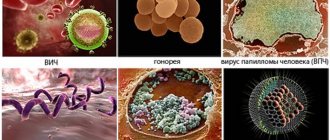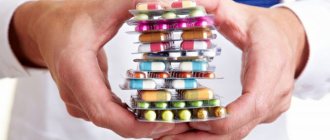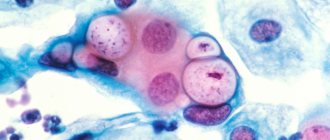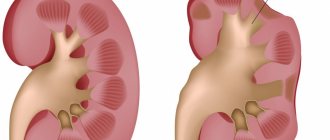And in men - from the urethra. Sometimes in the list of studies it is called a urethral smear.
A smear from the urethra in men is prescribed during a urological examination, with obvious signs of a urogenital infection, with indolent inflammatory diseases of the genitourinary system, or if the infection was detected during an examination of the partner.
The list of possible indications for prescribing a general smear and analysis for hidden infections in men looks something like this:
- discharge from the urethra;
- pain during or after urination;
- swelling and redness of the genitals;
- rashes;
- frequent urge to urinate;
- all inflammatory diseases of the genitourinary system (urethritis, prostatitis, vesiculitis, etc.);
- suspicion of any infection (gonorrhea, mycoplasmosis, chlamydia, trichomoniasis, etc.);
- infertility;
- preventive examination;
- detection of infection in a partner.
It is better to take the test not on your own, but on the direction of a doctor.
Indications for taking a urethral smear
The content of the article
A smear must be taken from men if they have symptoms of urological diseases. Often this procedure is carried out for the purpose of prevention. The initiator of the test can be the urologist or the patient himself. A smear from the urethra is especially important when examining a married couple in the process of planning pregnancy.
A signal to visit a urologist and get tested may be one of the following symptoms:
- Feeling pain and discomfort during urination or sexual intercourse.
- Allergic rash, ulcers, spots, redness on the skin of the genital organ.
- Pain in the lower abdomen, pain in the perineum or in the genital organ: sharp, aching, pulling, dull.
- Itching and burning in the urethral area.
- Any discharge from the urethra.
- Change in color or amount of urine or semen.
You should not wait until all urological symptoms appear together. You need to make an appointment with a urologist even if you suspect an infection, for example, after casual sex.
Description of the procedure
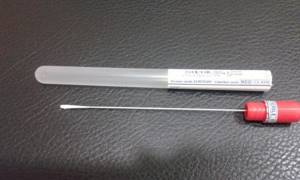
- A special disposable instrument is used to collect the material. The sterile device is in a kit, which the doctor opens immediately before the procedure. This will allow the patient to ensure that a new sterile device is used for taking the test.
- The material is collected using a bacteriological loop, a Volkmann spoon or a urogenital probe with a special tampon.
- The doctor inserts the device into the urethra to a depth of 20-40 mm.
- To better collect contents from the walls of the urethra, the doctor rotates the probe around its axis a couple of times.
- Using gentle rotational movements, the instrument is removed from the urethra.
- After this, the biomaterial is placed on a glass slide or in a sterile tube.
- If a smear is examined using the PCR method, then part of the collected material is placed in a special container. A PCR smear is needed to identify a hidden infectious pathogen.
The whole procedure takes about one and a half minutes. Many men experience some discomfort during the test. Most often it appears a couple of minutes after removing the instrument. But if there is inflammation of the urogenital tract, then the procedure itself is quite painful.
Typically, pain and discomfort disappear within an hour and are observed only during the first two episodes of urination. If the pain intensifies, a burning sensation and discharge appear, then most likely the procedure for taking the material has activated the infection, so you need to see a doctor again.
What will a urological smear show?
A smear from the urethra is done to determine the number of pathogenic microorganisms in the male genitourinary system, namely in the urinary canal. Moreover, based on the results of the analysis, it is possible to determine the species of those bacteria that led to the inflammation.
Examination of the contents of the urethra allows us to identify such deviations from the norm as:
- Pathogenic microflora – pathogens of STIs.
- Inflammation in the genitourinary system.
- The presence of microorganisms leading to purulent diseases.
- Fungal infection.
Examination of a smear from the urethra provides a comprehensive picture of the state of the genitourinary system and its functioning.
Sexually transmitted infections in men: diagnostic standards
17.09.2018
5719
1
According to the World Health Organization (WHO), more than 1 million people acquire a sexually transmitted infection every year. Every year, 357 million people are infected with one of 4 STIs - chlamydia, gonorrhea, syphilis, trichomoniasis. Most STIs are asymptomatic or cause few symptoms, which means that the STI may go unrecognized and, in some cases, have serious consequences for reproductive health beyond the immediate impact of the infection itself (for example, infertility or mother-to-child transmission). All this causes great concern among doctors, especially urologists and andrologists. Therefore, diagnosis is now key for patients with STIs. The editors of the Urology Digest discussed modern diagnostic capabilities for STIs in men with urologist, candidate of medical sciences, associate professor of the Department of Urology and Faculty Surgery of the Ivan State Medical Academy Denis Gennadievich Pochernikov.
| D.G. Pochernikov urologist, candidate of medical sciences, associate professor of the department of urology and faculty surgery of IvSMA |
“Urology Digest”: Denis Gennadievich, why do you think the topic of STIs remains relevant in many specialties - urology, gynecology, dermatovenereology?
D.G. Pochernikov: The relevance of this topic is due to the high prevalence of infections among the population of our country. This is especially true for young people under 30, who have experienced an increase in the number of sexual partners over the last decade. Official statistics clearly underestimate the numbers, and their inadequacy, it seems to me, is the result of neglecting to keep records of these diseases due to the large number of private appointments among gynecologists, urologists and dermatovenereologists.
In addition, infections are often unexpressed and even hidden in nature, occurring without a clear clinical picture, which leads to late referral to specialists already at the stage of complications, an increased risk of infertility, and a decrease in quality of life. The chronicity of the inflammatory process is also caused by the high prevalence of self-diagnosis and self-medication among the population.
Social reasons (low culture of the population, poverty, alcoholism, drug addiction, early sexual intercourse and frequent change of sexual partners) also play an important role and hinder the effective prevention of STIs in our country.
“Urology Digest”: What role do STIs play in the development of diseases of the male genital organs - balanitis, urethritis, prostatitis, epididymitis? What pathogens are most common in these diseases?
D.G. Pochernikov: STIs probably play a leading role in the development of the vast majority of inflammatory diseases of the reproductive system in men. Infection with STIs and the transition of inflammation to a chronic form occurs more easily against the background of dysbiotic disorders caused by opportunistic microorganisms, such as aerobic and anaerobic gram-negative and gram-positive bacteria, which may not manifest themselves for the time being. STIs occurring against such a background often lead to serious complications in the form of chronic prostatitis, epididymitis and reproductive dysfunction. Often, only a random examination reveals dysbiotic disorders caused by opportunistic microflora; the man does not even know that he is already sick. And only after yielding to the woman’s urgent requests does the partner go for an examination, usually in connection with planning a pregnancy.
Urology Digest: What diagnostic methods are currently considered the most accurate? Is it possible to trace the evolution of the development of diagnostic methods? Is there a “gold standard” for diagnosing STIs? According to guidelines from both domestic and foreign authors, only DNA diagnostics is an acceptable method for diagnosing sexually transmitted infections.
D.G. Pochernikov: The evolution of the development of diagnostic methods has undergone dramatic changes in recent years. Previously, the examination began with banal Gram smears, then methods of enzyme immunoassay, direct immunofluorescence appeared, and, finally, in the last decade, the PCR method, based on the detection of DNA and RNA of microorganisms, began to be used. Undoubtedly, DNA research is considered the most objective and accurate method for diagnosing sexually transmitted infections; today, throughout the world, PCR is considered the “gold standard” for detecting microorganisms.
In recent years, an even more accurate diagnostic tool has emerged, based on the real-time PCR method. Unlike classical PCR (end-point PCR), which establishes the presence or absence of a pathogen in the material being tested, real-time PCR (Femoflor®, Androflor® tests) answers the question about the number of bacteria and allows you to establish the ratio of microorganisms. Within the framework of the modern diagnostic paradigm, it is essential not only to identify pathogens, but also to establish the relative quantities (titers) of normal flora and opportunistic microorganisms, because dysbiotic processes can be the cause of complaints and clinical symptoms. In my opinion, the practical use of real-time PCR opens up broad opportunities for improving the objectivity of diagnosis and control of patient treatment.
“Urology Digest”: Are there any special indications and contraindications for using the method?
D.G. Pochernikov: Like any diagnostic method, real-time PCR has certain indications and limitations. Androflor® tests developed for clinical practice can be prescribed to patients with complaints and/or symptoms of inflammation of the lower and upper parts of the genitourinary system, as well as for preventive examination, even in the absence of complaints. At the appointment, I recommend submitting material for Androflor® to patients with acute and chronic urethritis, balanoposthitis, prostatitis, epididymitis, as well as patients who have addressed the problem of ineffective treatment, infertility, miscarriage in a spouse, for preconception preparation, before IVF.
Various materials can be sent for analysis - scraping and discharge from the urethra, prostate secretion or ejaculate. It is important to remember that PCR is a direct method for diagnosing infections, so material must be taken from locations closest to the suspected source of inflammation.
Like any other diagnostic method (microscopy, microbiology, etc.), real-time PCR requires compliance with the rules for patient preparation, conditions for collecting and storing material. They are standard and well known to all of us:
- sexual rest or barrier contraception for at least 3 days (to minimize the risk of contamination of the material with the microflora of the sexual partner),
- avoiding the use of antibiotics or antiseptics (including, for example, antibacterial soap),
- refraining from urinating for 3 hours before taking a scraping,
- recommendation to urinate and toilet the genitals before taking prostate secretions or ejaculate, etc.
I find it convenient for the patient to perform an Androflor® test using ejaculate; the patient can collect it at home through manual masturbation. All taken material must be stored in the refrigerator for no more than a day or frozen.
I especially want to dwell on the study of such material as urine. Unfortunately, it is not always suitable for diagnosing sexually transmitted infections and assessing microflora using real-time PCR. The fact is that in the absence of acute inflammation, the urine may contain an insufficient number of cells, which are one of the markers of the adequacy of the biomaterial. This is probably the only contraindication to the use of Androflor®.
"Urology Digest": What is the difference between Androflor and AndroflorScreen?
D.G. Pochernikov: Each study includes the detection of major pathogens (Chlamydia trachomatis, Mycoplasma genitalium, Neisseria gonorrhoeae, Trichomonas vaginalis) and quantitative assessment of representatives of normal and opportunistic microflora (bacteria, yeast fungi of the genus Candida). The main difference between these tests is the set of pathogens detected and, therefore, the indications for use. Androflor®Screen is a shorter profile; I recommend prescribing it mainly for diagnosing acute forms of diseases or during preventive examinations.
Androflor® is an expanded study, the spectrum of bacteria is supplemented mainly by obligate anaerobic microorganisms, it is advisable to use it in more complex clinical cases: in chronic forms of diseases, to determine the possible effect of infections on infertility, in preparation for IVF, for examining patients with complaints about ineffective treatment.
“Urology Digest”: Can you directly describe the research methodology itself - what material is needed for the research, from whom to take it?
D.G. Pochernikov: A very correct question, thank you! According to statistics, it is at the stage of taking material that up to 80% of errors occur. We have already said that for any direct method of diagnosing infections, it is important to correctly determine the localization. In case of chronic urethritis, balanoposthitis, it is necessary to take a scraping from the urethra - this is the most informative material for diagnosing these diseases.
If the doctor suspects epididymitis or prostatitis, then I recommend taking prostate secretion or ejaculate.
In order to differentiate urethritis from prostatitis, it is necessary to take two samples - both a scraping from the urethra and prostate secretion (or ejaculate).
In patients with asymptomatic sexually transmitted infections, or in patients referred by a gynecologist in connection with the examination of a woman regarding miscarriage, infertility or preconception, in my opinion, it is better to perform a semen analysis.
"Urology Digest": How to correctly interpret the results?
D.G. Pochernikov: You can read the analysis form very quickly, since a color coding that is intuitive to each of us is used - indicators that meet the norm criteria are marked green. Indicators with deviations from the norm criteria are yellow (moderate deviation) and red (pronounced deviation) markers. In addition, the laboratory report is provided at the bottom of the form.
For convenience, the indicators of the Androflor®Screen and Androflor® tests can be combined into groups. First, we pay attention to the top lines - these are indicators that assess the adequacy of the material submitted for research - human genomic DNA (shows the number of cells, there should be enough of them to pass the analysis), total bacterial mass (total contamination of the biotope) and the amount of transient microflora (the number of lactobacilli). The material that meets all the criteria is considered adequate, and the result of the study truly describes the state of the microflora. If the criteria do not meet the norm, it is recommended to re-take the biomaterial in compliance with the rules for preparing the patient and taking the sample (indicated in the conclusion on the analysis form), which we have already discussed.
Next, you need to look at the relative results column, which shows the numbers (proportions) of microorganisms in relation to the total bacterial mass. It is these values that are assessed when forming a conclusion about the state of the microflora. Candida yeast fungi are interpreted by absolute value; for pathogens, we interpret the fact of detection clinically. As an alternative to tabular form, the results are presented in graph form. Here, clinically significant amounts of microorganisms are also highlighted in color.
“Urology Digest”: Do you think it is necessary to treat only the patient or his partner too?
D.G. Pochernikov: Regarding the purpose of treatment, I would like to note several fundamental points. Of course, pathogenic microorganisms (Chlamydia trachomatis, Mycoplasma genitalium, Neisseria gonorrhoeae, Trichomonas vaginalis) require antibacterial treatment for both partners. But with opportunistic microorganisms, for example, ureaplasma, things are not so clear. Antibacterial treatment is required in all cases where ureaplasma is detected in both sexual partners and there is a history of miscarriage or infertility. In other cases, the prescription of antibacterial drugs is strictly individual and depends on the severity of clinical symptoms and the amount (titer) of the identified microorganism.
“Urology Digest”: Does the method have complications? How to avoid/prevent them?
D.G. Pochernikov: In my daily practice, I have never observed any complications when performing this technique. Sometimes patients experience objective discomfort after taking a scraping from the urethra for no more than a day. Undoubtedly, obtaining prostate secretion is associated with unpleasant sensations caused by massage of the prostate gland, but this applies to taking biomaterial for any analysis. In most cases, unpleasant sensations can be avoided by asking the patient to collect ejaculate at home.
“Urology Digest”: Have any clinical studies been conducted on the Androflor® test? What are the results?
D.G. Pochernikov: All Androflor® tests are registered in the Ministry of Health of the Russian Federation as a medical diagnosticum (registration certificate RZN No. 2016./4490). This means that the technique has undergone serious clinical validation, comparison with reference methods (microbiological culture, sequencing) and has proven high accuracy and reproducibility of results (about 99%). Doctors from various regions of Russia took part in the research, several thousand samples of biomaterial were analyzed, and statistical processing of the results was carried out. By the way, our department took part in the testing of Androflor®; we have been familiar with these tests for more than 5 years. Scientific clinical projects continue to this day, their results have been partially published and prepared for publication.
“Urology Digest”: What do you see as the fundamental advantages of the Androflor® and AndroflorScreen® tests over other methods?
D.G. Pochernikov: Clinical guidelines on urology, gynecology, and dermatovenereology in recent years consider it categorically unacceptable to use PIF or ELISA techniques for diagnosing sexually transmitted infections. Molecular genetic methods are coming to the forefront around the world, and real-time PCR technology is truly leading the way. Compared to the classic version of PCR, Androflor® is much more informative, giving a complex of qualitative and quantitative results. Obligate anaerobic bacteria that are difficult or uncultivable by microbiological culture are determined in Androflora® accurately and quickly, providing new opportunities in modern diagnosis and effective treatment of urological diseases.
Urology Digest: Thank you for a very informative conversation! Interviewed by V.A. Shaderkina
The article was published in the journal “Urology Digest” No. 4 2021, pp. 53-62
Topics and tags
Infection in urology
Comments

Kiselev Evgeniy Alekseevich - 09.17.2018 - 11:50:45
I use it. Convenient and informative. But the partner’s gynecologists are not always in the know, and Femoflor, from experience, identifies fewer pathogens.
To post comments you must log in or register
What diseases can be diagnosed?
Men often underestimate the capabilities of urethral smear analysis and ask questions about the pathologies that it allows to diagnose. So, without a smear, a good urologist will not make a single definitive diagnosis regarding inflammation in the organs of the genitourinary system. This is due to the fact that many infections are equally asymptomatic or give the same symptoms.
Thanks to the results of the analysis of discharge from the urethra, it is possible to establish prostatitis, gonorrhea, urethritis, chlamydia or ureaplasmosis, etc. Further clarifying techniques may be required.
Benefits of analysis
: due to its accessibility, speed and information content, the study of a smear from the urethra for flora occupies one of the first positions in the diagnosis of diseases of the male genitourinary system.
How does the procedure work?
Taking a smear from the urethra in men is a quick procedure that does not take much time. The procedure is carried out with a sterile instrument, which is inserted into the urethra by a doctor. Then several rotations are made and the tool is removed. In men, the urethra has a very narrow canal and is therefore very sensitive. Therefore, some patients may experience pain. If the patient has inflammatory processes, the pain may persist even after the procedure. If the doctor is qualified and experienced, he will perform the procedure in such a way that the patient will not feel any discomfort. The only thing that will cause some discomfort is a slight stinging sensation during the first urination.
As soon as the procedure is completed, the doctor removes the flora culture into a sterile test tube, and part of the taken material is carefully applied to the glass. To identify some hidden infections, the genitourinary organs are massaged with special movements before the procedure. PCR diagnostics are mandatory. The material applied to the glass is pre-dried in air. Then it is stained and the reaction of the particles is examined microscopically.
The study usually takes no more than six days. When a patient is diagnosed with an STD or any infection, both partners undergo treatment, since re-infection, transmitted exclusively through sexual contact, is possible. During the treatment period, it is necessary to abstain from intimate life.
Preparation
Taking a smear for any study requires compliance with a number of requirements and recommendations:
- Refrain from intimate contact at least 2 days before the scheduled examination.
- Do not empty your bladder a couple of hours before taking a smear to ensure more accurate results.
- Perform genital hygiene before going to bed, but you should not do this before visiting a doctor, so as not to wash off the infectious agents.
- A week before sampling, stop taking medications other than those prescribed by your doctor. Notify your urologist about taking medications, especially antibiotics.
How is the smear procedure performed?
Material for analysis for bacteriological culture is taken from the urethra by placing a special probe into it. The probe is a thin soft stick. It is inserted to a depth of about 3 cm. Of course, all materials and test tubes must be completely sterile. After inserting the probe into the urethra, it is twisted slightly to collect secretions. The instrument is then removed and placed in a test tube.
This procedure is not pleasant only in moral terms. In fact, the man feels only slight discomfort during the analysis. Sometimes it is a little unpleasant for several hours after taking a smear. To reduce discomfort, doctors advise the patient to massage the prostate on their own.
The process of collecting material lasts no more than 10-15 minutes. The result can be obtained in 5-7 days.
Types of tests for infections
There are two main types of tests for men: a general smear for flora and a test for sexually transmitted infections. In the first case, the doctor takes the material using a special probe and actually makes a smear on a glass slide. Afterwards it is stained and examined under a microscope. Such a smear allows you to determine the number of leukocytes, the presence of various bacteria, intracellular parasites, protozoa, and fungi. The smear itself does not allow you to specifically determine the type of bacteria, because under a microscope many of them look the same. For example, the mysterious word “coccal flora” may hide staphylococcus, streptococcus, and a large number of other types of microorganisms. In order to conduct a more detailed and specific study, they take an infection test.
A smear for latent infections is not a smear in the truest sense of the word. The doctor collects urethral discharge in approximately the same way, but then the resulting material is placed in a sterile nutrient medium and sent for examination.
The study is carried out using the polymerase chain reaction (PCR) method. It allows you to detect even a small amount of DNA of infectious agents in the material. If a man is an asymptomatic carrier, he will also be infected.
Infection testing can be qualitative or quantitative. In the first case, a negative or positive result will simply be written on the form: that is, an infection was found or not. In the second case, the amount of the pathogen will also be determined.
Decoding the results
Only a urologist can decipher the results of the analysis, but knowledge of some indicators will help to approximately assess the condition of the male genitourinary system and understand what processes are occurring in the body.
Analysis of a smear from the urethra is assessed for such indicators as leukocytes, cocci, trichomonas, epithelium, mucus.
- Leukocytes
in the human body perform a protective function, so these cells can be present in the microflora, but in small quantities. The presence of inflammation is indicated by an increase in their number. This is most often a sign of urethritis or prostatitis. - Epithelial cells
are also present in the smear in small numbers. Epithelial tissue covers the inner surface of the urethra. An increase in the number of these cells indicates an inflammatory process. - Slime
. The test sample must contain a moderate amount of mucus, otherwise we can talk about an infectious process. - Various cocci
(enterococci, streptococci and staphylococci) may be present in the liquid in small quantities. They have the opportunity to reproduce only in an environment favorable for this. With a high concentration of cocci, urethritis can be assumed. - Gonococci, Trichomonas.
A smear from the urethra of a healthy man should be completely absent. Their detection in the microflora indicates the development of gonorrhea or trichomoniasis. - Conditionally pathogenic flora
. Some microorganisms may be present in the microflora in moderate quantities. This condition is considered normal.
| Index | Normal in sight |
| Slime | Moderate amount |
| Epithelium | 5-10 |
| Gonococci | None |
| Leukocytes | Up to 5 |
| Trichomonas | None |
| Cocci | Moderate amount |
Contraindications and advantages of the method
The procedure is taking a smear from the urethra, which is necessary and carries important information about the diseases that are detected or absent. The smear is performed within a couple of minutes and is almost painless. With its help you can obtain useful information about the urinary system and sexual functioning.
For prevention, a man also needs to visit a urologist, as serious diseases can be detected in time. This will make it possible to quickly prescribe the necessary treatment. During the prescribed treatment, it can completely get rid of the disease, prolong sexual life, and preserve sexual function.
Contraindications:
- The patient has a high body temperature;
- The procedure cannot be performed when the patient’s body is undergoing an acute inflammatory process;
- For serious mental health problems;
- State of alcohol and drug intoxication in an aggressive stage;
- education, any trauma to the penis;
Many men, when they receive test results and they show the presence of the disease, begin to panic or withdraw into themselves. Should not be doing that. You need to remain calm and come back for a follow-up appointment with the doctor. If necessary and to clarify the diagnosis, the doctor will send the patient for additional tests. If they are not required, he will prescribe surgical treatment. If a sexually transmitted infection is detected, you must notify your sexual partner about this. It is strictly forbidden to carry out independent treatment, especially with folk remedies. In such cases, only productive treatment prescribed by an experienced doctor will help.
As a rule, people run to the doctor when they are seriously ill. The male part of the population rarely appears at the urologist, considering the procedure painful and unpleasant. Take care of your health, it is the same for everyone. Visit your urologist regularly. The life and health of a person depends on a timely and correct diagnosis made using various tests.
The Logon Gynecological Clinic also provides services:
- Appointment with a urologist
- Urology treatment for men
- Cost of visiting a urologist
- Urology treatment in Moscow
Features of taking a smear for prostatitis
To obtain the necessary material for research, a urologist performs a finger massage of the prostate through the anus. During the massage, the prostate gland secretes a secretion that exits through the urethra. The doctor analyzes this liquid.
No special preparation is required before submitting prostate secretions for analysis. In cases where it is not possible to obtain a secretion, the doctor collects the first portion of urine into a container. It contains a high concentration of secretion.
The results obtained during the study show whether there are any deviations from the norm and how much they exceed acceptable values.
Interpretation of prostate secretion analysis
Prostatitis can be diagnosed in a patient based on a number of indicators that exceed the normal value.
| Index | Norm | Deviation from the norm |
| Amount of prostate secretion | 1-2 ml | Exceeding the volume indicates congestion, and a decrease is a sign of prostatitis |
| Color | Transparent white | Inflammation of the prostate gland gives the fluid a white or yellow color; a reddish tint indicates the presence of blood. |
| pH level | Neutral or slightly acidic (6.4-7) | Acute prostatitis is manifested by a shift in pH to the acidic side. Chronic prostatitis gives an alkaline reaction. |
| Smell | The specific smell of sperm | Any other, uncharacteristic odor |
| Red blood cells | Absent or appear in single quantities | Presence in large quantities - prostatitis or prostate cancer |
| Epithelial cells | 1-2 in sight | The more epithelial cells in the test sample, the stronger the inflammatory process |
| Leukocytes | Up to 10 per field of view or 300 cells/µl when using a counting chamber | A high number of white blood cells in the fluid is a characteristic sign of inflammation. Do not forget about the possibility of leukocytes entering the secretion from the urethra. |
| Macrophages | Present in single quantities | In chronic prostatitis, the number of macrophages increases sharply |
| Amyloid bodies | Completely absent | The presence of even a small amount of amyloid bodies indicates congestion |
| Giant cells | None | Appears in chronic prostatitis |
| Böttcher crystals | Present in single quantities | Changing their number does not particularly affect the condition of the genitourinary system in men |
| Gonococcus | Absent | The presence of gonococci is a sign of gonorrhea |
| Lecithin grains | Very much (from 10 million/ml) | With inflammation of the prostate gland, their number decreases |
| Fern symptom | Positive reaction | Negative reaction |
| Flora (bacteria) | Single | Abundant amounts are detected in bacterial prostatitis |
| Fungi | None | With prostatitis they are found in different quantities |
| Trichomonas | Not found | Its presence is a sign of trichomoniasis |
What diseases can be detected using a smear?

The study can help doctors identify pathologies such as:
- Urethritis and its type according to the pathogen . Inflammatory processes in the urethra.
- Ureaplasmosis . Bacteriological infection, sexually transmitted. It is characterized by clear discharge from the urethra, painful sensations in the groin and lower abdomen.
- Prostatitis . Inflammation of the prostate gland of various origins. Depending on the source of the problem, the symptoms vary.
- Gonorrhea . A sexually transmitted pathology caused by gonococci. Spreads to the mucous membranes of the urethra and other organs of the urinary system. Copious purulent discharge begins from the urethra, and ulcers appear on the mucous membranes.
- Chlamydia . A sexually transmitted disease caused by bacteria of the genus Chlamydia. Purulent discharge, itching, and burning appear.
The analysis can also show other pathologies caused by microorganisms.
What to do if the test result is bad
Not all male representatives know what measures need to be taken if an unsatisfactory research result is obtained.
The main thing is not to panic, not to run to friends and acquaintances for advice, and not to self-medicate. Any pathology detected by analysis of a smear from the urethra can be treated.
- First, contact your urologist for advice and a referral for additional tests. The treatment regimen depends on their results.
- If deviations from the norm turn out to be serious, the doctor determines the disease by exceeding the indicators and prescribes comprehensive treatment.
- If a man shows signs of pathology, his partner also needs to be examined. This will prevent re-infection.
- Complex treatment includes taking antibiotics, antivirals, drugs to enhance immunity and local therapy. Compliance with all doctor’s instructions guarantees a quick recovery for the man and his partner.
Don't want to be treated? Be prepared for the fact that any pathology of this kind can subsequently lead to male infertility or impotence. By the way, these are minimal tragic consequences of dangerous infections. In some situations, men lose the organ completely, continuing to live with a urine drainage tube instead of a penis.
Indications for analysis
The analysis is prescribed for preventive purposes during a full examination of the patient by a urologist or at a consultation with an andrologist, to identify certain pathologies of the genitourinary system or the general health of a man in case of suspected infertility or preparation for IVF.
A urologist or other highly specialized doctor will prescribe a study if there are complaints about problems with urination, sexual function, pain or cramping. Other unpleasant symptoms may also appear:
- Urine has changed color, smell or consistency;
- Discharge from the penis appears;
- Irritation of the skin in the area of the external genitalia;
- Inability to urinate.
Urologists recommend undergoing a preventive examination and standard tests at least once every 6 months.
MAKE AN APPOINTMENT WITH A UROLOGIST
Klokov Andrey Nikolaevich
Urologist-andrologist, doctor of the highest category
Make an appointment
Where to make a urethral smear for a man in St. Petersburg, prices
<
p style=”text-align: justify;”>Urethral smears in St. Petersburg can be given to men at the Diana clinic. The examination is performed anonymously, the results of the urological smear are given in hand or, if the patient wishes, they can be received by e-mail. Appointment with a urologist in St. Petersburg - 1000 rubles. Here you can do a urological ultrasound and cure prostatitis.
If you find an error, please select a piece of text and press Ctrl+Enter


